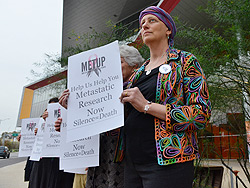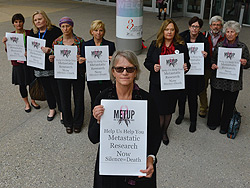Patients Protest at Medical Conference
It has been said there are only two certainties in life – death and taxes. Actually, there are a few more. The annual ASCO meeting always takes place during the first week of June, the annual RSNA meeting happens the week after Thanksgiving. The annual ASH meeting and the San Antonio Breast Cancer Symposium (SABCS) take place during the first full week of December. USCAP usually occurs in March. There are probably of hundreds or thousands of other examples in other specialties and fields of large meetings of like-minded people at the same time each year.
For medical conferences, patients rarely attend or present, but increasingly advocate groups are attending and ASCO, in particular, which I am most familiar with, has a large advocacy corner in the enormous McCormick Place that seems to grow every year where patient advocacy groups can promote their activities, raise funding, provide information, network and conduct B2B activities.

 SABCS also has an active patient advocacy group and last week at the meeting, members of MET UP, as reported by Medscape, demonstrated at the meeting. This advocacy group, recently formed, and mentioned here (see: Pink to Black for Metastatic Breast Cancer) is “committed to changing the landscape of metastatic breast cancer through direct action”, according to their website, metup.org. The site goes on to mention “We protest and demonstrate” and “We want at least 30% of federal breast cancer research dollars to be spent on metastatic disease, with a focus on translational research.” In the past I have been familiar with their “die ins” where women lay on the ground illustrating how many women die daily from metastatic breast cancer. At SABCS they held a peaceful protest outside the Susan G. Komen Brinker Awards for Scientific Distinction Session, highlighting the role of research and necessary funding to their cause. The groups’ signs read “Help Us Help You. Metastatic Research Now. Silence = Death”.
SABCS also has an active patient advocacy group and last week at the meeting, members of MET UP, as reported by Medscape, demonstrated at the meeting. This advocacy group, recently formed, and mentioned here (see: Pink to Black for Metastatic Breast Cancer) is “committed to changing the landscape of metastatic breast cancer through direct action”, according to their website, metup.org. The site goes on to mention “We protest and demonstrate” and “We want at least 30% of federal breast cancer research dollars to be spent on metastatic disease, with a focus on translational research.” In the past I have been familiar with their “die ins” where women lay on the ground illustrating how many women die daily from metastatic breast cancer. At SABCS they held a peaceful protest outside the Susan G. Komen Brinker Awards for Scientific Distinction Session, highlighting the role of research and necessary funding to their cause. The groups’ signs read “Help Us Help You. Metastatic Research Now. Silence = Death”.
This group of patients feels disenfranchised as I have mentioned previously with such slogans as “Pink is not a Cure” and “Pinktober”, with its emphasis on screening and early-stage detection doing little to address the metastatic patient community. Less than 10% of all breast cancer research dollars today goes towards metastatic breast cancer research.
The runs, races, walk and bike rides and pink cleats and baseball bats and football gloves each Pinktober perhaps do not see metastatic patients the same way they can highlight treatment successes with early-stage patients living many years with no evidence of disease as success stories for screening and early detection. Their voices are being heard in Washington, DC and across the country, including San Antonio now during the regularly scheduled large gathering of breast cancer oncologists, surgeons, radiologists, pathologists, reconstructive surgeons and researchers.
In My Humble Opinion recently wrote, “As a physician, there is few words worse than the word metastases. It not only creates fear in the hearts of our patients but cleaves a chunk out of our souls. We are never as hapless in our calling as when we admit that we are mere unarmed foot soldiers in the face of this raving beast. We are not helpless. We can comfort and palliate. Cure, however, becomes an ever increasing implausibility.”
A couple of cancer survivors I rode with this Fall on 200-mile bike rides in support of young women with breast cancer had brain metastasis and pushed through. Some have been living with Stage 4 disease for many years.
Perhaps a demonstration such as this as happened at other meetings. I doubt one would occur at USCAP, the single largest gathering of pathologists annually each March, but I am surprised patient demonstrations do not occur more frequently or are not being covered by the media.
I would think that families affected by Alzheimer’s disease or autoimmune diseases, or other chronic debilitating and potentially fatal conditions do not assemble more often at gatherings of practioners and researchers for specific diseases or conditions. Of course these meetings are designed to highlight current practices and active research for diagnostics or therapeutics that show promise with further validation needed. And it is extremely competitive in terms of sharing what the presenters submit and discuss through a peer-review process and selection for abstracts, posters or oral presentations. And the “really cool stuff” that either is not ready for that year’s meeting or whose intellectual property is not protected yet does not get discussed. Then there are issues with what another laboratory or company might have “in development” that is not openly discussed in public forums people can tweet about, but discussed in closed door meetings under NDA.
The point is, there is a selection bias and limitations on what may get presented at these meetings to begin with and patient’s may not understand that while it seems we are all working together to understand disease processes, pathophysiology, treatments, side effects, cures and complications, it is not altogether that way. And then you can go into the exhibit floor and find dozens of companies selling similar products that are innately competitive to one another, each thinking their 88-gene test panel or their methodology or assay, or hardware or software is better than the other.
So while we pride ourselves on doing our part to better diagnose and treat disease and often times have personal connections which drive us to our respective stations in healthcare, whether you are a physician, researcher or manufacturer, we all think our way is better or suffer from the “not invented here” syndrome and promote our accomplishments as examples of what others should follow. And medical conferences represent some fundamental problems in medical research and healthcare as a business that have several flaws. While these patient protests may have their place at medical conferences, the problems with lack of funding or recognition of particular diseases starts long before the polished talks and exhibits that need to be addressed by patients and healthcare providers alike.
































